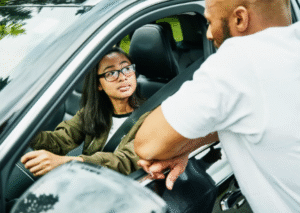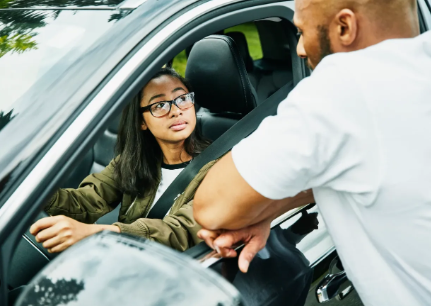Parental Influence: How Your Driving Patterns Affect Teenage Behaviour
Parental Influence How Your Driving Patterns Affect Teenage Behaviour. Though many ignore the most crucial driving lesson they have already been imparting—by example—parents often worry about educating their teenagers how to drive safely. Long before teenagers start driving, they have spent years in the passenger seat observing how their parents handle speed restrictions, tailgaters, and traffic signals. Children’s observations behind the wheel have equal impact with what they are taught.
Regularly handling automobile accident cases involving young drivers, Koch & Brim LLP claims, parental behaviour behind the wheel significantly influences how teenagers approach the road. Teenagers are more prone to copy the behaviours they have seen most often, either good or bad, whether it is speeding, distracted driving, or failing to yield. It reminds us that good driving is modelled rather than merely taught.

Parental Influence Passive Learning’s Authority
Young children absorb behaviour patterns from observation early in life. In the car, that same idea holds. When a parent regularly follows driving rules, buckles their seatbelt, and acts calmly under pressure, those behaviours quietly establish a lifetime standard. Teenagers start creating an internal road plan for both emotional and physical navigation even without official guidance.
But the reverse is equally valid. Unknowingly normalising these risky behaviours are parents who often speed, use their phones, or experience road rage. Teens who have been guided by someone they trust and respect may see their driving habits as reasonable or “realistic.”
Parental Influence Teens Mirror More Than You Would Imagine
Even the little routines can be persistent. Regular failure to indicate turns or merges late in traffic by a parent could cause them to think it’s not really important.
But a teenage learner of driving notes it and files it away. The same applies to more major problems such rolling through stop signs, neglecting crosswalk pedestrians, or answering phones while driving.
See also 7 Game-Changing Tech Tools Transforming Online Poker in 2025
Well after the permission phase of an adolescent, this mimicking can last. It becomes part of how people see driving generally—not only a law to follow, but a lifestyle moulded by early exposure.
While changing your personal behaviour might not seem important, to your teen it could make the difference between a responsible and a dangerous attitude.
Underlying Emotional Control Behind the Wheel
Driving calls for emotional control as much as for steering and braking. How you manage tension behind the wheel determines the emotional tone your teen is probably going to inherit. Your reaction to traffic congestion—profanity, tailgating, or aggressive lane changes—tells them that impulsive responses are okay.
Conversely, keeping cool, inhaling deeply, and choosing patience in trying circumstances help teenagers learn the emotional resilience they need to drive safely. Emotional consistency can be as life-saving as a seatbelt in a high-stress situation like Las Vegas traffic.
Distracted Driving Begins Right Here at Home
Teenagers’ accidents are clearly caused in great part by inattentive driving. Where, however, do those distractions start? For many, the habit starts with seeing parents change their GPS, text, or scroll while driving. Teenagers are significantly more prone to multitask behind the wheel once they are driving alone when they view it as normal.
Not only does a no-phone rule protect your safety, but it also tells your teen a strong message. Not the exception, but the default is distraction-free driving by modelling complete attention on the road.
Implementing Policies Without Apologies
If your teen has seen you text and drive, it will be difficult to persuade them that this is unsafe. The same applies to not bucking through yellow lights or without wearing a seat belt. Teenagers are fast to point out hypocrisy, which compromises your teaching authority.
See also creative ideas for hosting virtual game evenings with friends and family.
Match your words to your behaviour to avoid conflicting messages. Your teen should see you acting the same if you expect them to observe driving rules and stay attentive.
Consistency in modelling helps to establish trust and emphasises the need of rules—not only as guidelines but also as actual safety precautions.
Strike the Early Conversation Starting Point
Starting the driving topic does not wait till your teen receives a learner’s permit. Discuss your choices as you go; explain why you are pulling over to respond to a text or slowing down in a school zone. These teachable opportunities enable your child to grasp not only the guidelines but also the justification behind safe driving.
Your teen will be more at ease asking questions and expressing worries when they start driving the sooner you initiate this communication. It also prepares the ground for shared responsibility—that is, when you two are working to be safer, better drivers together.
Why More Modelling Than Lecturing Matters
Rarely do lectures stick, but continuous behaviour does. Teenagers who have grown up witnessing safe driving practices modelled often are more likely to embrace them. That means the most effective driving lesson you can provide occurs every day, in traffic, on the road, or even just from pulling out the driveway—not in a parking lot.
Treating every drive as a model of safety and responsibility helps your teen develop lifetime habits. And in a place like Las Vegas, where road risks abound, that impact might make all the difference.
Safer Futures and Safe Habits
Teenagers’ impression of driving—including the technical aspects as well as the emotional ones—is much influenced by parents. By being aware of your personal driving habits, you not only make sure your family gets at their destinations without incident but also help to ensure your child’s future road safety.
Professional legal assistance is available for families coping with the aftermath of a car accident involving a teen or seeking liability or insurance guidance.
